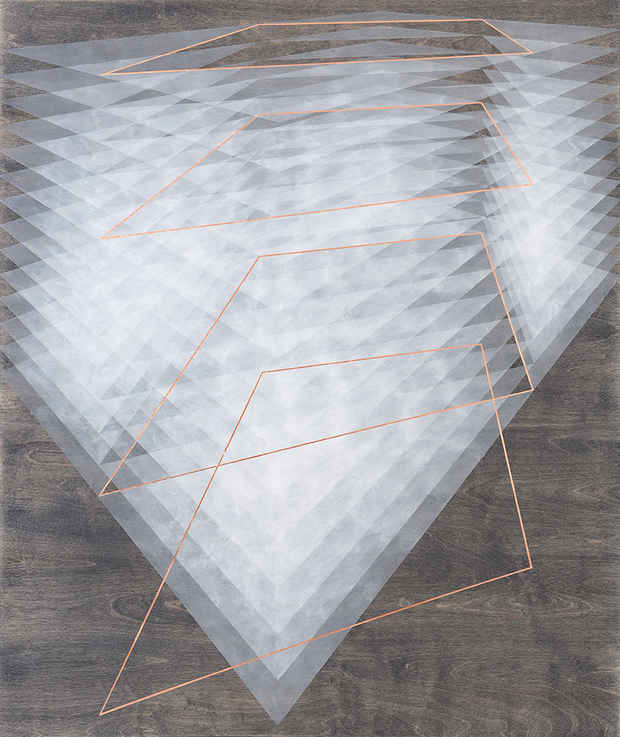Steven MacIver “Out of Orkney”
Dillon Gallery

[Image: Steven MacIver "Vantage B" (2016) Acrylic and copper on birch wood panel 47 x 39 in.]
This event has ended.
Dillon Gallery presents “Steven MacIver: Out of Orkney,” its second major solo exhibition of new works by Scottish artist Steven MacIver.
In preparation for this exhibition, Steven MacIver began making drawings of the landscape and undulating lines referring to the topography of Orkney, the small group of islands off the north coast of Scotland where the artist was born and brought up. It was through these drawings (which he did from memory) that he remembered the old World War Two look out posts on the coastline of Orkney. Taking a break from the landscape imagery, MacIver made drawings of these look out posts, three of which are less than a mile from the artist’s childhood home. What the artist now compares to stark pieces of minimal sculpture in the mound of Judd or Morris, were for the artist as a young boy, fantastical forts and play spaces.
Focusing on these minimal concrete structures full of sharp angles and straight lines against their organic surrounding allowed MacIver to explore the organic vs. manmade relationship in spaces. To fully expand on this idea, MacIver used birch wood panels. The natural grain of the wood is an ideal surface to juxtapose with the structured, linear imagery. By building the compositions in thin skins of semi transparent paint, the artist was able to allow the natural qualities of the surface come through and create a new field of depth, one which would sit alongside the perspective driven space of the compositions.
This illusion of space is something that has featured in MacIver’s previous work, but with this series, he wanted to use the “rules” of perspective and geometry and all that is “correct” about them to create imagery that, through repetition of process and small rhythmic movements, actually appears abstracted. That is to say, while each composition is perfectly “correct” or “figurative” in its spatial construction, the resulting image leans toward abstraction. The structure and angles, still inspired by his memories of the lookout posts, become a pattern or mesh on the wood grained surface. By creating a body of work which follows these rules of process, he was able to use this framework as a means of support, rather than a limitation.
Steven MacIver believes that drawing should be viewed as a language, with all the subtleties and idiosyncrasies of meaning, structure and syntax. His research and practice focuses on developing the linguistics of drawing: its role in the mediation of communication between the artist and the viewer, evoking real, remembered and imagined environments. MacIver’s work has developed these concepts through the investigation of mark-making, exploring the diversity of methods through which line may be made. He calls his artistic method a type of “excavation” because he uses a scalpel to remove paint in a reductive method from the canvas. The result is a structured surface that is both glossy and flat: a cross between drawing and painting.
Steven MacIver was born in the Orkney Islands and completed his BA in Fine Arts at Gray’s School of Art in Aberdeen and his MFA at the Slade School of Art. Following his graduation in 2004, MacIver was honored with the Sainsbury Scholarship in Painting and Sculpture at the British School at Rome. Amongst the many awards and grants this gifted young artist has already received, the Rome Prize for study awarded to him by the Slade School placed him as one of the leading young artists from Britain. He currently lives and works outside Oxford.
Media
Schedule
from June 15, 2016 to August 12, 2016
Opening Reception on 2016-06-15 from 18:00 to 20:00